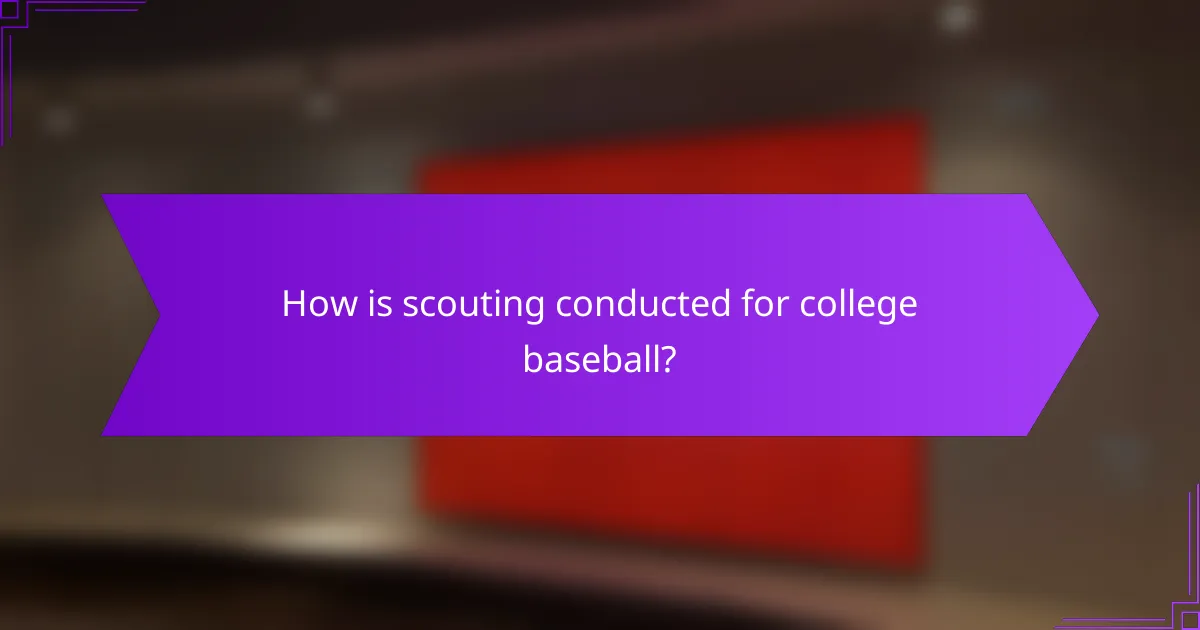College baseball serves as a critical platform for player development, emphasizing skill enhancement and performance through structured training and coaching. Aspiring athletes navigate various pathways, including high school recruitment and showcase tournaments, to gain visibility among college scouts, who employ systematic evaluation methods to assess players’ potential for collegiate competition.

How does player development work in college baseball?
Player development in college baseball focuses on enhancing athletes’ skills, knowledge, and performance through structured training and coaching. This process involves various components, including skill training programs, coaching methodologies, performance metrics, and player feedback systems, all aimed at preparing players for higher levels of competition.
Skill training programs
Skill training programs in college baseball are designed to improve specific abilities such as hitting, pitching, and fielding. These programs often include drills, practice sessions, and specialized coaching aimed at refining techniques and enhancing overall performance.
Colleges may offer a variety of training options, including individual sessions, team practices, and strength and conditioning programs. Players typically engage in these programs multiple times a week, focusing on both physical and mental aspects of the game.
Coaching methodologies
Coaching methodologies in college baseball vary widely but generally emphasize a combination of technical instruction and strategic development. Coaches often employ a mix of traditional techniques and modern analytics to guide players in improving their game.
Effective coaching involves not just teaching skills but also fostering a competitive mindset. Coaches may use video analysis to provide visual feedback, helping players understand their strengths and areas for improvement.
Performance metrics
Performance metrics are essential in college baseball for assessing player development and effectiveness. Metrics can include batting averages, on-base percentages, pitching statistics, and defensive efficiencies, which provide a quantitative basis for evaluating progress.
Colleges often utilize advanced statistics and technology, such as radar guns and motion capture systems, to track player performance. These metrics help coaches make informed decisions about player development and game strategies.
Player feedback systems
Player feedback systems are crucial for ongoing development in college baseball. These systems typically involve regular evaluations and discussions between players and coaches regarding performance, goals, and areas needing improvement.
Feedback can be formal, such as end-of-season reviews, or informal, like daily check-ins. Encouraging open communication helps players understand their development path and fosters a culture of continuous improvement.

What are the key pathways to college baseball?
The main pathways to college baseball include high school recruitment, travel baseball leagues, and showcase tournaments. Each pathway offers unique opportunities for players to demonstrate their skills and gain visibility among college scouts.
High school recruitment
High school recruitment is a primary avenue for players to enter college baseball programs. Coaches often scout local high schools to identify talented athletes, so performing well during the regular season and in playoffs can significantly enhance a player’s visibility.
To improve recruitment chances, players should maintain strong academic records and engage with their coaches about potential opportunities. Building relationships with college coaches through communication and attending camps can also be beneficial.
Travel baseball leagues
Travel baseball leagues provide players with the chance to compete at a higher level and gain exposure to college scouts. These leagues typically involve teams that travel regionally or nationally, allowing players to showcase their skills against strong competition.
Joining a travel team often requires a financial commitment, including fees for tournaments and travel expenses. However, the investment can pay off, as many college recruits are identified during these competitive events.
Showcase tournaments
Showcase tournaments are events specifically designed for players to display their talents in front of college coaches and scouts. These tournaments often feature multiple teams and allow players to participate in drills and games that highlight their abilities.
When attending showcase tournaments, players should focus on their performance, but also on networking with coaches and other players. Preparing adequately by practicing skills and understanding the tournament format can help maximize the experience and potential recruitment opportunities.

How is scouting conducted for college baseball?
Scouting for college baseball involves a systematic evaluation of players through various methods, including in-person observations, data analysis, and video reviews. Scouts focus on a player’s skills, athleticism, and potential to determine their fit for college programs.
Scouting reports
Scouting reports are detailed documents that summarize a player’s abilities, performance metrics, and potential. They typically include assessments of hitting, pitching, fielding, and base running skills, along with physical attributes like speed and strength.
These reports often use a standardized grading scale, allowing coaches and recruiters to compare players easily. Common elements include a player’s statistics, strengths and weaknesses, and recommendations for development.
Video analysis tools
Video analysis tools are essential in modern scouting, providing visual insights into a player’s mechanics and performance. Coaches and scouts use software to break down game footage, highlighting specific skills and techniques.
These tools can track metrics such as pitch speed, swing angles, and fielding movements, offering a comprehensive view of a player’s capabilities. Many colleges now require players to submit highlight reels as part of their recruitment process.
College coach evaluations
College coach evaluations are critical in the scouting process, as they provide firsthand insights into a player’s work ethic, attitude, and team dynamics. Coaches often assess players during games and practices, looking for not just talent but also how well they fit into a team environment.
These evaluations can influence recruitment decisions significantly, as coaches prioritize players who demonstrate strong leadership qualities and a commitment to improvement. Regular communication between scouts and coaches helps ensure that evaluations are accurate and comprehensive.

What are the criteria for selecting college baseball players?
College baseball player selection is based on a combination of physical attributes, statistical performance, and character assessments. These criteria help coaches and scouts identify talent that fits their program’s needs and culture.
Physical attributes
Physical attributes play a crucial role in the selection of college baseball players. Key factors include height, weight, speed, and overall athleticism. For example, pitchers often benefit from a strong build and good arm strength, while position players may be evaluated on their agility and speed on the bases.
Coaches typically look for players who can demonstrate a combination of strength and endurance. A common benchmark for speed is the 60-yard dash, where times under 7 seconds are often considered competitive for college-level players.
Statistical performance
Statistical performance is another vital criterion in selecting college baseball players. Coaches analyze metrics such as batting average, on-base percentage, earned run average, and fielding percentage to gauge a player’s effectiveness. These statistics provide a quantitative measure of a player’s contributions on the field.
For example, a batting average above .300 is generally seen as a strong indicator of a hitter’s capability, while pitchers with an earned run average below 3.50 are often viewed favorably. It’s essential for players to maintain consistent performance throughout the season to attract attention from college scouts.
Character assessments
Character assessments are increasingly important in the selection of college baseball players. Coaches seek players who demonstrate strong work ethic, teamwork, and resilience. These traits can often be evaluated through interviews, references, and observations during practices and games.
Players who exhibit leadership qualities and a positive attitude can stand out during the selection process. Additionally, being coachable and willing to adapt to feedback is crucial for success at the collegiate level, as it reflects a player’s potential for growth and development within a team environment.

What are the differences between NCAA divisions in baseball?
The NCAA divides college baseball into three main divisions: Division I, Division II, and Division III. Each division has distinct rules regarding scholarships, competition level, and player eligibility, impacting player development and scouting opportunities.
NCAA Division I
NCAA Division I baseball is the highest level of collegiate competition, featuring the most prominent programs and the largest athletic budgets. Teams can offer full athletic scholarships, attracting top talent from high schools and junior colleges.
The competition is intense, with a regular season that includes around 50 games, followed by conference tournaments and the NCAA tournament. Players often face rigorous training schedules and travel demands, which can significantly impact their academic commitments.
For aspiring professional players, Division I offers the most visibility to scouts and major league teams, making it a critical pathway for those aiming for a career in baseball.
NCAA Division II
NCAA Division II baseball provides a balance between athletics and academics, allowing for partial athletic scholarships. This division emphasizes the student-athlete experience, promoting a more manageable schedule compared to Division I.
Teams typically play around 40 games in the regular season, with opportunities for postseason play. The level of competition is still high, but players may find more time to focus on their studies and personal development.
Division II can be a viable option for players seeking to develop their skills while maintaining a strong academic focus, making it an attractive pathway for those who may not receive Division I offers.



